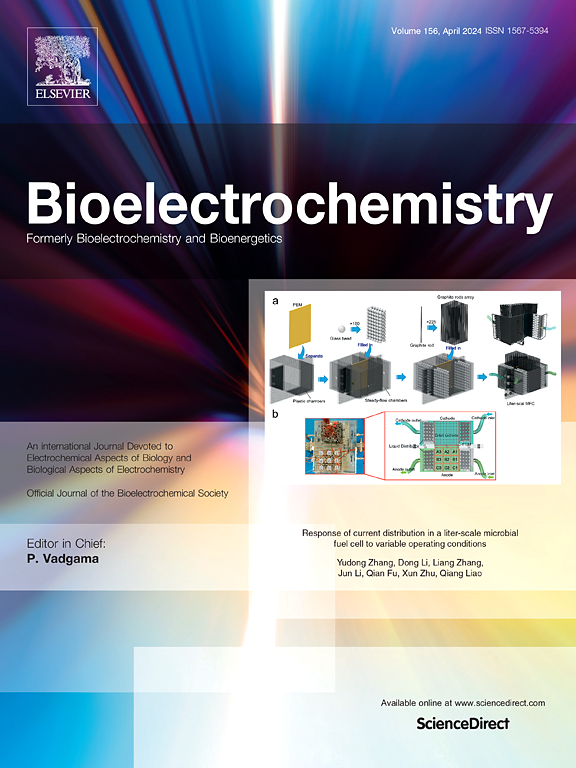Electrochemical and bioelectrochemical ammonium recovery from N-loaded streams using a hydrophobic membrane
IF 4.8
2区 化学
Q1 BIOCHEMISTRY & MOLECULAR BIOLOGY
引用次数: 0
Abstract
Bioelectrochemical systems enable the recovery of ammonium from wastewater with low energy requirements and as a concentrated nitrogen-rich stream. This work aims to thoroughly investigate different cathodic electrode configurations and to optimize the operational conditions for active ammonium recovery from synthetic wastewater as concentrated ammonium sulphate. Different applied current intensities (50 mA, corresponding to 5 A m−2, and 75 mA, corresponding to 7.5 A m−2) and initial ammonium concentrations (between 0.3 and 3 g L−1 N-NH4+) were tested in an abiotic electrochemical system to understand the upper threshold of the used three-chamber configuration with hydrophobic membrane in terms of ammonium recovery rate (Rrec). With an external current of 75 mA, the highest value was 55 gN-NH4+ m−2 d−1 when removing 97 % from an initial ammonium concentration of 3 g L−1. Bioelectrochemical ammonium removal/recovery was evaluated under different applied potentials (0.8, 1.0, 1.2, and 1.4 V) using two configurations: a Nickel-based gas diffusion electrode (GDE) and a configuration with the cathode (stainless steel or nickel foam) physically separated from the hydrophobic membrane. The highest removal rate (Rrem) (21 gN-NH4+ m−2 d−1) was exhibited for stainless steel cathode at 1.4 V mainly due to its higher current density, which increased the cations migration. This higher Rrem also led to a higher Rrec (17 gN-NH4+ m−2 d−1).
疏水膜从含氮废水中回收电化学和生物电化学铵
生物电化学系统能够以低能量需求从废水中回收铵,并作为浓缩富氮流。本工作旨在深入研究不同的阴极电极配置,并优化从合成废水中回收活性铵作为浓硫酸铵的操作条件。在非生物电化学系统中测试了不同的施加电流强度(50 mA,对应5 A m−2,75 mA,对应7.5 A m−2)和初始铵离子浓度(0.3 ~ 3g L−1 N-NH4+),以了解所使用的三室疏水膜结构在铵回收率(Rrec)方面的上限。当外部电流为75 mA时,当初始铵浓度为3 g L−1时,去除率为97%时,最高去除率为55 gN-NH4+ m−2 d−1。采用两种配置:镍基气体扩散电极(GDE)和阴极(不锈钢或泡沫镍)与疏水膜物理分离的配置,在不同的应用电位(0.8、1.0、1.2和1.4 V)下评估了生物电化学对铵的去除/回收。不锈钢阴极在1.4 V电压下具有最高的去除率(Rrem) (21 gN-NH4+ m−2 d−1),这主要是由于其较高的电流密度促进了阳离子的迁移。较高的Rrem也导致较高的Rrec (17 gN-NH4+ m−2 d−1)。
本文章由计算机程序翻译,如有差异,请以英文原文为准。
求助全文
约1分钟内获得全文
求助全文
来源期刊

Bioelectrochemistry
生物-电化学
CiteScore
9.10
自引率
6.00%
发文量
238
审稿时长
38 days
期刊介绍:
An International Journal Devoted to Electrochemical Aspects of Biology and Biological Aspects of Electrochemistry
Bioelectrochemistry is an international journal devoted to electrochemical principles in biology and biological aspects of electrochemistry. It publishes experimental and theoretical papers dealing with the electrochemical aspects of:
• Electrified interfaces (electric double layers, adsorption, electron transfer, protein electrochemistry, basic principles of biosensors, biosensor interfaces and bio-nanosensor design and construction.
• Electric and magnetic field effects (field-dependent processes, field interactions with molecules, intramolecular field effects, sensory systems for electric and magnetic fields, molecular and cellular mechanisms)
• Bioenergetics and signal transduction (energy conversion, photosynthetic and visual membranes)
• Biomembranes and model membranes (thermodynamics and mechanics, membrane transport, electroporation, fusion and insertion)
• Electrochemical applications in medicine and biotechnology (drug delivery and gene transfer to cells and tissues, iontophoresis, skin electroporation, injury and repair).
• Organization and use of arrays in-vitro and in-vivo, including as part of feedback control.
• Electrochemical interrogation of biofilms as generated by microorganisms and tissue reaction associated with medical implants.
 求助内容:
求助内容: 应助结果提醒方式:
应助结果提醒方式:


